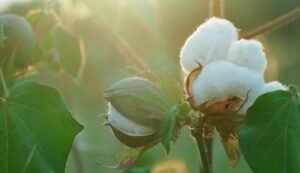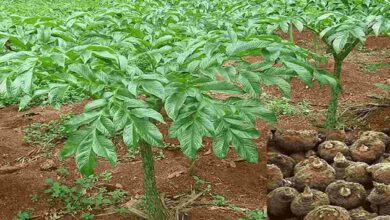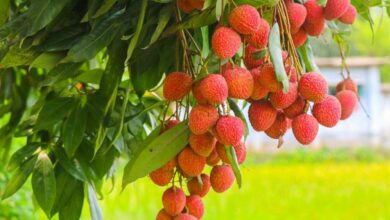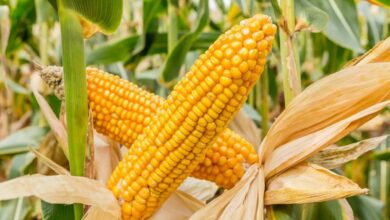AGRICULTURE
Cotton Crop: This insect is very dangerous for the crop; know how to solve this problem
Cotton Crop: The pests and illnesses that affect cotton are the largest issue that farmers deal with while growing the crop. The crop output is directly impacted if cotton pests are not managed in a timely manner. The cotton crop may be totally destroyed by a variety of pests and illnesses. It is critical that farmers be aware of such a circumstance beforehand. We have provided information on managing pests and diseases in cotton crops today in response to the farmers’ concerns. Give us specific information about them.

The approaches for integrated insect pest control in cotton crops are as follows:
Cotton Symptoms and Insects
Sucking Insects
- Milli Bug: These insects adhere to various plant components similarly to white wax. By sucking the juice from almost every portion of the plant, the larvae and adults of this bug harm the crop. The plants that are affected continue to be bushy dwarfs. Only a few bolls develop, and they are still little and unsightly. Ants are drawn to the honey secreted by the insects, and they spread the bug from one plant to another.
- Jassid: By sucking the juice from the underside of the leaves, its larvae and adults damage the crop. They attack the leaves, causing them to bend downward, get crooked, become red, and eventually dry out and fall.
- Two jassids per leaf is the economic cutoff level.
- White fly: This insect carries leaf curl disease and mostly harms the crop before to blooming. By sucking the plant juice, this insect’s larvae and adults damage the crop. A black fungus develops and the plants’ ability to perform photosynthesis is reduced when the insects release honey. 8–10 individuals per leaf or 20 adults per leaf before to 9 am is the economic threshold level.
Aphid: By sucking the juice from the leaves and tender developing shoots, aphid larvae and adults damage the crop. The leaves wither and grow twisted as a result.
Administration
- Plant-resistant cultivars that have been suggested.
- Don’t use too much nitrogen and sow on time.
- In the summer, deep plowing eliminates several stages of disease-causing germs and pests.
- Bicanthrin 8% + Clothianidin 10% SC 10 ml/10L, Fipronil 7% + Flonicamid 15% WD + G 8 g/10L, or Sulfoxaflor 21.8% SC 7.5 ml/10 l of water should be sprayed as needed.
- Spray Acetamiprid 20% SP 1 g/10L, Aphidopyropen 50 g/L DC 20 ml/10L, or Flonicamid 50% WG 3 g/10L on aphids as needed. Or mist 4 ml/10 l of water with 9.2% DC isocycloceram.
- Guard against parasites such as ladybird beetles and chrysoperla.
- For the first eight to nine weeks, keep the field clear of weeds.
- To lessen the red insect invasion, pick the pods at the appropriate period.
Symptoms and Pests
- The cotton of open bolls becomes black, as do the leaves and branches.
- The larvae and adults of the red bug of Kapara consume the juice of the leaves or green bolls. The cotton gets red spots, while the afflicted bolls have yellow spots. Bugs are squashed during the cotton removal process, lowering the quality of the cotton and oil.
- Adult cotton dusky bugs are 4-5 mm long, brown or ash colored, and have dull white wings. Nymphs have no wings and are tiny. The larvae and adults both consume the fluid from the raw seeds, which prevents them from ripening and keeps them light in weight. The adults are crushed during the removal process, discoloring the cotton and lowering its quality and market value.
Administration
- Spray Imidacloprid 17.8 SL at a rate of 250 ml/hectare, Acetamiprid 250 g/ha, or Oxydemeton Methyl 25 EC at a rate of 1200 ml/hectare for the hoppers if each leaf has two adults or nymphs.
- Use a yellow trap to keep an eye on whiteflies.
- Apply Flonicamid 50% WG 3 g/10L, Aphidopyropen 50 g/l DC 20 ml/10L, or Acetamiprid 20% SP 2 g/10L as needed. Alternately, add 10% EC 16 ml/10L pyriproxyfen or 20% WG 7.5 g/10L water to make a spray.
- Use diafenthiuron 50% WP 10 g/10L, dinotefuran 20% SG 4 g/10L, or flonicamid 50% WG 3 g/10L water to spray aphids as needed.
- Alternatively, depending on the aphid infestation, use Beauveria bassiana at a rate of 2 g/L.
- First, gather and eliminate the red bugs.
- For red bugs and dusky bugs, combine fluvalinate 25% EC with 4 ml/10L water and spray as needed. Cotton fields and the surrounding area should be cleared of alternative host plants, such as Parthenium grasses.





